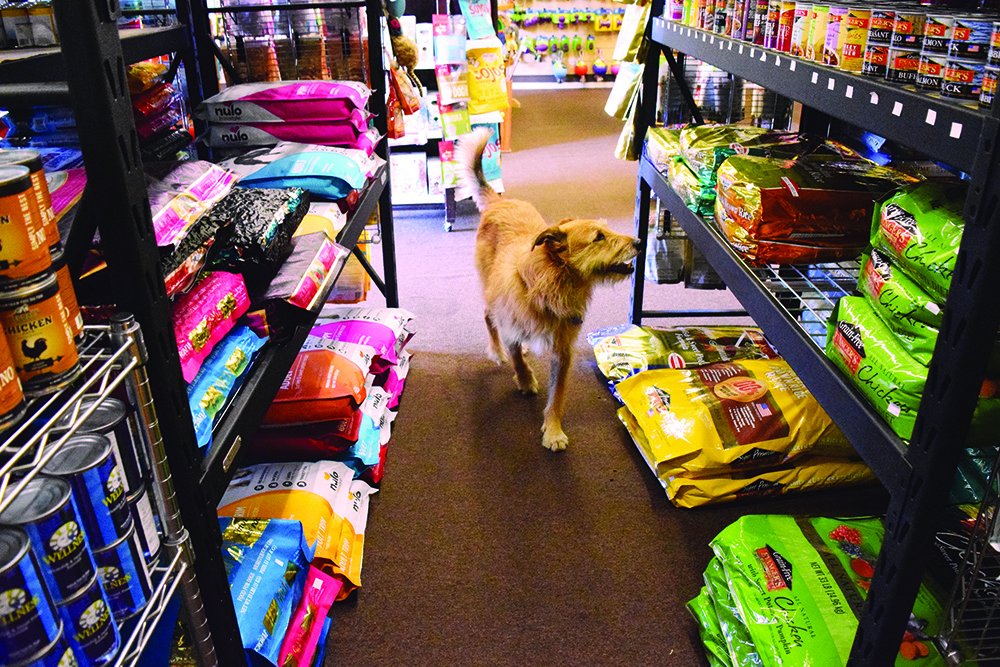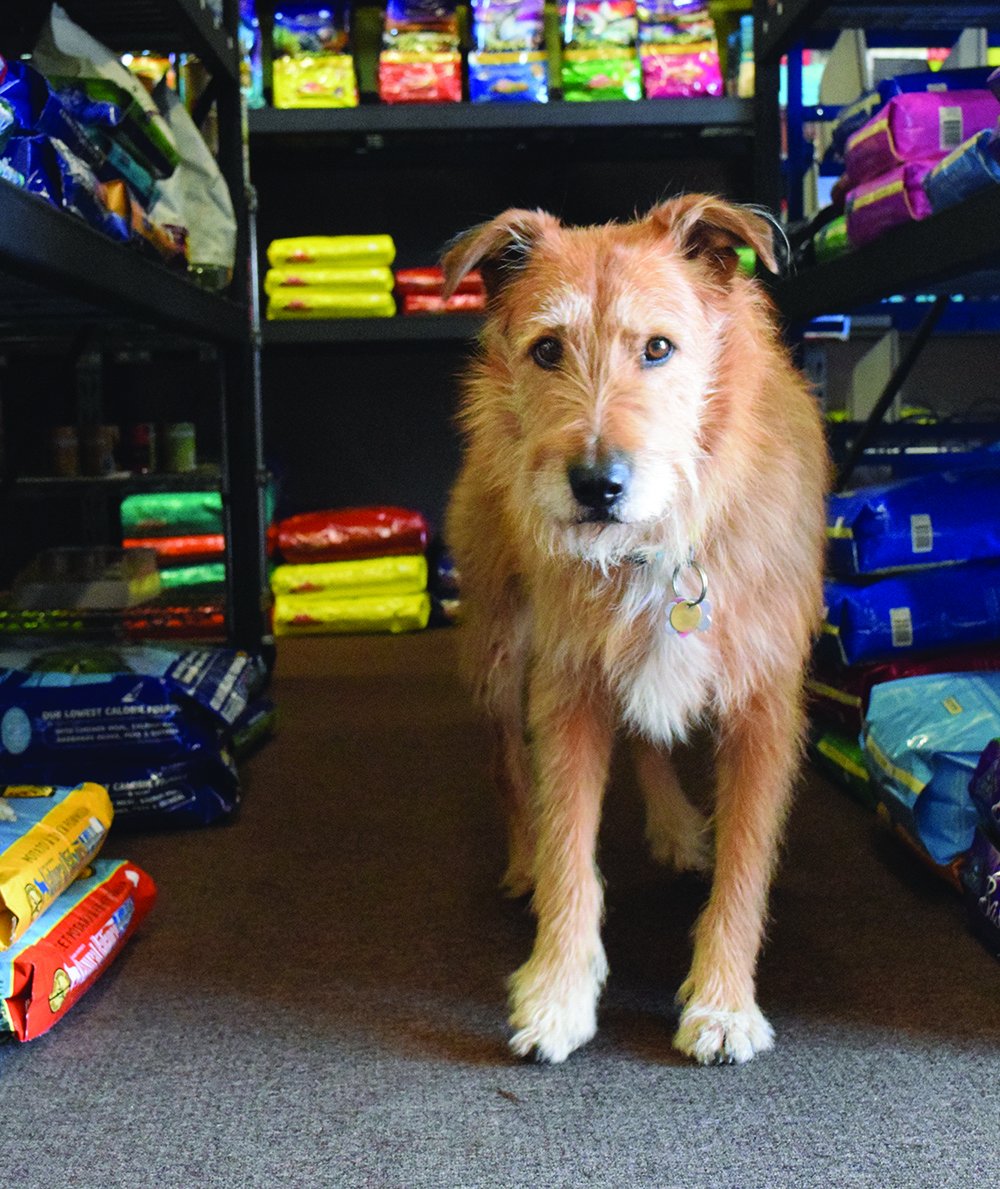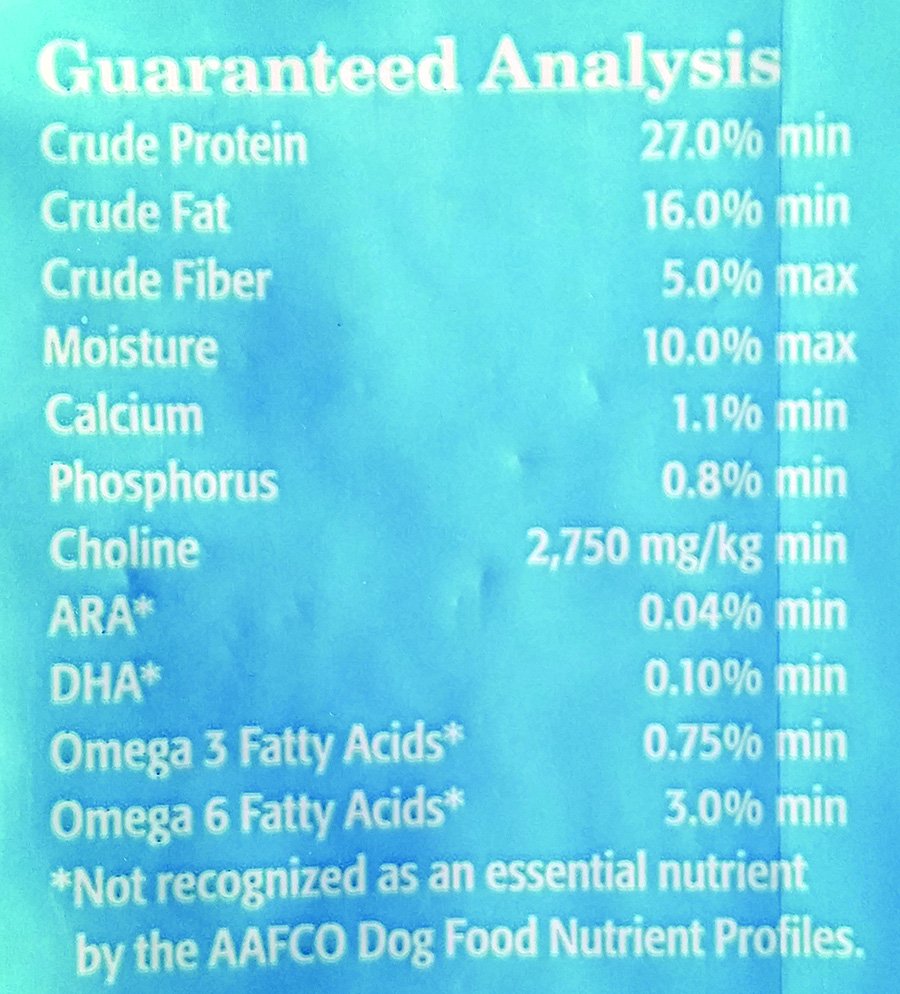Be honest: The main reason that many of you are reading this right now – the reason that many of you have subscribed to WDJ! – is to learn which dog foods are the “best” ones. Am I right? If so, then I’m sorry to have to report that there isn’t any product out there that is “best” for all dogs . . . . On the other hand, I’m happy to tell you that there probably are a bunch of foods that are “best” for your individual dogs! You’re going to have to do some homework and some feeding trials, though, in order to learn which foods work (and which ones don’t) for each of your dogs. Not to worry, though; we’ll walk you through it!

Many people are under the impression that all foods that are labeled as “complete and balanced” contain an ideal, uniform amount of nutrients – just enough of what dogs need, but not too much. That would be lovely, if anyone knew precisely what the optimum nutrient levels for dogs are, or if the nutrient requirements for all dogs were the same. But there is no more consensus among veterinary nutritionists about optimum canine nutrition than there is about optimum human nutrition among human nutrition experts. There are legal standards and definitions for what constitutes “complete and balanced” dog food, but the appellation really only gets you in the ballpark.
Whole Dog Journal has assembled a complete list of approved dry foods, which you can access right here.
In the U.S., there are three very different ways that a dog food can be designated as “complete and balanced.” Once you know what they are, you can see why any single product can’t be counted on to ensure that your dog will receive optimal nutrition if the “complete and balanced” product is fed as a sole diet long-term. Let’s take a quick look at the three qualifying standards for a “complete and balanced” canine diet.
Speaking from a regulatory perspective, “complete and balanced” means that the food either (A) contains at least the minimum levels of all the nutrients (and not more than the maximum levels of some nutrients) that have been determined to be essential for dogs (this is called a “nutrient levels” qualification); or (B), has sustained a population of dogs in a laboratory setting for a period of time (“feeding trial” qualification); or (C) has been formulated to closely resemble another product made by the same company that had passed a feeding trial (“family member” qualification).
The disparity between these qualifying methods has resulted in anything but nutritionally uniform formulation from pet food company to pet food company. Instead, there is a wide range of nutrient levels in the “complete and balanced” dog foods on the market. And this is why we don’t want you to search for just one ideal food for your dog – because there may not be one! Instead, we recommend hedging your bets, as it were, by rotating between a number of good foods that suit your dog.
Foods, Not Food
The variety of qualifying methods for “complete and balanced” diets results in a product category with a wide range of amounts of macronutrients (protein, fat, fiber, and moisture) and micronutrients (vitamins and minerals). If you feed your dog only one type of food for months and months – perhaps years! – you are, in effect, concentrating the nutritional attributes of that food in your dog.
Is the food a little higher than it should be in some minerals? Does it contain the absolute minimum of some vitamins? These things may not present a problem for any individual dog in the short term, but after months (or years!) of eating the same food, these less-than-ideal nutrient levels can cause health problems, such as a toxic accumulation of minerals (e.g., iron, copper, selenium), or persistently low vitamin D or E levels in the blood.
Fortunately, these problems are easily prevented by switching your dog’s diet from food to food – and using products from different manufacturers, too, since some food makers use the same vitamin/mineral “premix” in all of their products. Switching foods frequently helps guarantee that your dog will receive nutritional “balance over time,” if not in any single product.
“But, wait!” you say. “My vet/breeder/rescue group/doggie daycare operator/best friend told me that I should never switch foods, because it will upset my dog’s stomach. In fact, I switched foods once, when my pet supply store stopped carrying my favorite food, and my dog had diarrhea for a week! I can’t go through that each time I need a new bag of food!”
Here’s a secret: Most dogs have far more robust digestive systems than we do. And for millennia, they have been opportunistic feeders, eating literally anything edible in front of their noses, including grasses, fruits, eggs, animals they killed and animals they found dead (including mammals, birds, fish, amphibians, reptiles, bugs, you-name-it), as well as whatever scraps of human’s food that they could charm us into giving them, as well as the stuff we were throwing away . . . . Including poop. Our poop and almost any other poop dogs come across is fair game: deer, rabbit, sheep, cow, horse. Sorry to get disgusting, but it’s true. The point is, dogs are built to be able to eat just about anything and make use of it, without getting sick.
So why did your dog suffer from a week’s worth of diarrhea the last time you switched his food? When this happens, it’s generally due to one of two things:
You’ve been feeding the same food for months (years?) and his body now lacks a variety of digestive enzymes and gut bacteria. The body quits producing enzymes it doesn’t need, and the population of gut bacteria that help break down your dog’s food changes in response to what it’s fed. If you have fed only a rice and lamb diet for years, and switch overnight to a chicken and quinoa diet, it will take your dog’s body a week or two to adjust.
Your dog is allergic to or intolerant of one or some of the ingredients in the food, or intolerant of diets with the macronutrient levels present in that food. We recommend recording all of your dog’s dietary changes, and his response to them, in a notebook or calendar. It’s the best way to identify trends in any adverse reactions he has to certain ingredients or nutrient levels in his foods (such as a reliably bad reaction to diets containing fish, or to particularly high-fat foods).
In general, the more variety you build into your dog’s diet, the more robust his digestive system will become (unless, again, he has allergies to or a reliable intolerance of certain ingredients). Just keep in mind that the more frequently you switch foods, the more alert you need to be to any problem your dog might experience after each meal.

For example, if you feed one type of food in the morning and another at night, and your dog starts vomiting at 10 p.m., will you be able to definitely tie his digestive upset to his most recent meal? If he’s home alone all day and has a dog door, say, it could be possible that he was actually vomiting on and off all day; in that case, you could end up suspecting his dinnertime food, when in fact it was the breakfast food that contained something that disagreed with him. Your unique schedule and ability to observe your dog throughout the day may dictate how much variety is right for your dog.
Let’s Go Shopping!
We hope by now we’ve convinced you to look for at least a couple of good foods for your dog the next time you go shopping. If you are shopping for a new dog, or are newly convinced to look for a few prospects to add variety to your dog’s diet, schedule your next shopping expedition for a day when you have a significant amount of time to do some things and observe some things that you may never have done or observed before!
Here’s an ideal strategy for a “major” shopping day, when you have time to really study all your dog’s dietary options at your local pet supply store.
1. First, walk around the entire area where the dry dog food is displayed, checking to see what brands are present in that store. All brands are not available in every store. Things you should know:
– It’s the pet food distributors that service your area that really decide which pet food brands are available in a given area. National distributors carry mostly high-volume products from the corporate pet food giants; smaller regional companies may specialize in the “natural/holistic” niche of products. Distributors have to be able to move a certain amount of any given company’s food in order to make it worth their while to carry it – and the same is true for your local store, too.
– The type of store where you shop will partly determine what brands are available to you. Some pet food companies sell only to independent pet supply stores; others sell their products mostly in “pet specialty chains” (think Petco and PetSmart, as well as smaller, regional chains such as Centinela Feed, Kriser’s Natural Pet Store, Pet Food Express, and Pet Supplies Plus). Still others concentrate their sales in “big box” stores (Target, Walmart) or grocery store chains.
– Pet food companies offer incentives – sometimes in the form of credit or even as actual payments – to pet supply stores for premium placement of their products. In many stores, the first brands you see as you enter the dry dog food section will have paid the store to be positioned in the most prominent or first location you encounter when entering. The higher-cost foods (which are generally, but not always, also the higher-quality products) will be clustered together close to the most premium position. And, in general, the lowest-cost (generally, the lowest-quality) foods will be located in the farthest corner of the dry dog food section.
In a minute, we’re going to discuss what sort of ingredients meet our selection criteria for good foods, and which ingredients signal a low-cost, low-quality product. If the store where you habitually shop has only a few (or none) of the products that meet the selection criteria discussed more fully below, you should probably shop elsewhere!
When I first moved to the town where I have lived for the past decade, the sole pet supply store in town offered only one brand of food for sale: Science Diet, a company that (at the time) made not a single product that met my selection criteria. And there are no specialty (human) food stores (such as Whole Foods or Trader Joe’s) in my town that might sell a premium pet food. So for years, I drove to one of two nearby towns (about 20 miles to either one) that had independent pet supply stores with a good selection of premium foods to choose from.
People in even more remote areas may end up having to have good foods shipped to them directly from online pet specialty businesses; that’s an increasingly affordable option these days.
2. Next, walk around more slowly and look at the food prices, getting an idea of which foods are within your budget, and which are too costly to consider.
Price is an important, inescapable factor in the buying decision for many dog owners. It may not strongly influence dog owners who are wealthy, nor a family with a good income and just one dog, or people with small dogs. But for those of us with several dogs, people who foster or breed, and people with very large dogs, the price of food can’t be completely disregarded, especially when it can range so widely, from scarily low (such as $20 for 52 pounds of Kal Kan Dry Adult Dog Food, or $.38 per pound) to prohibitively high (such as $98 for a 28.6-pound bag of Champion’s Orijen “Regional Red” variety, or $3.32 per pound!).
We have always recommended buying the best food that’s in your budget for your dog – but not everyone can buy the most expensive food, nor should they feel guilty for not doing so. Part of being a responsible pet owner is making sure you can afford his care. It doesn’t make sense to buy expensive food if you might have to surrender your dog because you can’t pay for an emergency vet bill (not to mention the electric bill!).
It should also be said that some dogs do absolutely fine on lower-cost, lower-quality food. If they didn’t, not nearly as much of these foods would be made and sold! But some dogs on low-quality diets will suffer from poor digestion (the most frequent signs being chronic diarrhea or just very loose stools and/or persistent gas); rough, dull coat and itchy skin; and/or poor overall health. Whenever a dog has chronic signs of disease, we recommend improving his diet. But if he looks like a million bucks on a diet comprised of lower-cost foods, more power to you.
I myself have been in the position of buying different foods for the different dogs in my home: the highest-quality food for my hypersensitive, elderly Border Collie, and a lower-cost food for the younger, healthy foster dogs and litters of foster puppies that may stay with me for months at a time.
A final consideration regarding the cost of food: At some price point, it might make more sense to feed a home-prepared diet, or a good commercial raw (frozen or dehydrated) diet. Some of the best and most expensive dry dog foods are actually comparable in price (or even more expensive than) some of these less-processed (and, we would argue, healthier) diets.
3. Now, the exciting part: reading labels! This is where the rubber hits the road. We’ll start with some of the big type on the front of the bags.
Originally, we wrote #2 as “. . . look at food prices and ingredients,” because you’ll find that there’s usually a direct correlation between the food prices and their ingredients.
There is usually big print or a starburst of some kind on the label announcing when a product is grain-free. Often, these foods are more expensive than foods that contain grain. Whether you want or need a grain-free food for your dog is a topic for another day, but suffice to say here that not all dogs benefit from them, and some dogs do much better on a more conventional formulation with grains. If you are already aware that your dog’s health and/or digestion is better when he’s on a grain-free diet, then these are the foods you need to focus on. If you don’t have a compelling reason to try them, and your dog is already in fine condition and a good weight, we wouldn’t recommend switching to this type of food.
Similarly, food companies generally go out of their way to make it obvious when a food contains novel proteins (such as kangaroo, venison, buffalo, rabbit, and so on). These products also tend to cost more than products made with prosaic proteins, such as beef, chicken, lamb, turkey, and pork. Just as with grain-free foods, products that are made with novel proteins are very useful for dogs who are allergic to or intolerant of the far more common protein sources, but come with an unnecessarily high price for dogs who don’t need them.
Time to start flipping the bags over and reading the ingredient lists.
Things You Want to See on the Ingredient Lists
The following are desired traits – things you want to see on the label.
Lots of animal protein at the top of the ingredients list. Ingredients in pet food, just like human food, are listed in order of the weight of that ingredient in the formula, so you want to see a top-quality animal protein at the top of the list.
Importantly, that animal protein should be identified by species – chicken, beef, lamb, etc. “Meat” is an example of a low-quality protein source of dubious origin. “Poultry” is more specific but not specific enough!
Animal protein “meals” are made through a process called rendering, wherein the animal tissues (muscle, fat, skin, connective tissue, and some smaller amount of bone, hair, and/or feathers, depending on the species) are ground, and then heated to separate the fat and reduce the moisture. If it’s made from rendered chicken, the resulting product is chicken meal; if made from lamb, it’s lamb meal, etc. Just as with the fresh animal protein, look for a named species (i.e., “chicken meal”) but avoid “meat meal” or “poultry meal.”
When a fresh, named meat is first on the ingredient list (such as “chicken”), there should be a named animal-protein meal (such as “chicken meal”) in a supporting role to augment the total animal protein in the diet. The closer to the top of the ingredient list that this supporting meal appears, the better.
The ingredient list of the best foods will start out with something like, “Chicken, chicken meal . . .” and go on from there. Fresh meat contains a lot of (heavy) water, so if meat is first on the list, it acts like a diluted protein source; while it adds an appealing flavor and aroma to the food, it doesn’t actually contribute that much protein. That’s why another named source of animal protein should appear in the top three or so ingredients.

Whole-food ingredients: vegetables, fruits, and/or grains or other carbohydrate sources such as potatoes, peas, chickpeas, or sweet potatoes. Fresh, unprocessed food ingredients contain nutrients in all their complex glory, with their vitamins, enzymes, and antioxidants intact. Don’t be too alarmed by one or two “fractions” (a byproduct or part of an ingredient, like tomato pomace or oatmeal), especially if they are lower on the ingredient list. But the more fractions present in the food, and the higher they appear on the list, the lower quality the result.
Undesirable Ingredients
We also think it’s important that you know some ingredients to look out for. Avoid the following:
Meat byproducts, poultry by-products, meat byproduct meal, and poultry byproduct meal. Some of the animal tissues that go into the ingredients that are identified on labels as animal byproducts are highly nutritious, such as lungs, spleens, kidneys, brains (of some animal species, not all), livers , blood, bone, fat, and emptied stomachs and intestines. Poultry byproducts also includes necks, feet, and underdeveloped eggs. In addition, poultry byproduct meal may contain poultry heads.
However, believe us when we say that these ingredients are not handled as nicely as the higher-value cuts of meat of which they are “byproducts.” Because they are not headed for human consumption, these products are not kept clean and chilled through processing and transport; it’s a given that whatever bacterial burden may flourish during this time will be reduced by later processing. As they become oxidized – rancid – these animal tissues develop a certain level of peroxide. Pet-food producers may specify byproducts with lower peroxide values, but these cost more.
A “generic” fat source such as “animal fat.” This can literally be any mixed fat of animal origin; it need not have originated from slaughtered animals. Meaning, it can be obtained from renderers that process dead animals. “Poultry” fat is not quite as suspect as “animal fat,” but “chicken fat” or “duck fat” is better (and traceable).
Added sweeteners. Dogs, like humans, enjoy the taste of sweet foods. Sweeteners effectively persuade many dogs to eat foods comprised mainly of grain fragments (and containing less healthy animal protein and fats).
Artificial colors, flavors, or preservatives (i.e., BHA, BHT, ethoxyquin). The color of the food doesn’t matter to your dog. And it should be flavored well enough with healthy meats and fats to be enticing. Natural preservatives, such as tocopherols (vitamin E), vitamin C, and rosemary extract, can be used instead. Note that natural preservatives do not preserve foods as long as artificial preservatives, so owners should always check the “best by” date on the label and look for relatively fresh products.
Other Considerations
Many of the other things we want you to read the label for are neither good nor bad, just things you need to be aware of when shopping for your specific dog. Remember, each dog is an individual, and while it’s great when it works out that all of your dogs do well on the same food, don’t take it for granted that you will be able to feed them all with the same products.
You will need to become aware of how much protein and fat your dog thrives on – how much is too much, and how much is too little. Top-quality foods contain a lot more protein (and often, more fat, too) than lower-quality foods, so you may have to reduce the amount of food you feed quite a bit if you switch from a low-quality food to a really good one. (One upside is that good foods are much more digestible, and your dog’s poop should shrink a lot, too.)
The fat and protein content appears on the label in an important section called the “guaranteed analysis” (GA). The nutrient levels reported on the GA are literally guaranteed. If a food is tested by a state feed control official, or even by a lab at the bequest of a private consumer, and the food fails to contain even one of the nutrients listed on the GA in at least the amounts shown there, the food may be subject to enforcement.

The more nutrients that a pet food company lists on the GA, generally, the more confident they are in their formulations. We admire companies that include this detail for nutrients that consumers may be paying extra for, such as omega 3 fatty acids, or nutraceuticals such as glucosamine and chondroitin.
There is no nutritional difference between “puppy” food and food that is for dogs of “all life stages.” All “complete and balanced” foods are required to have a “nutritional adequacy” or “AAFCO” statement somewhere on the bag, though sometimes these are printed in incredibly tiny type. The statement contains information about which type of dogs the food has been formulated for: adults only, or “all life stages.”
Food that is designated as “puppy” food on the front label may say that it’s formulated for dogs of “all life stages,” “puppies,” “growth,” or “growth and reproduction” on the nutritional adequacy statement; all of those phrases mean essentially the same thing. The required nutrient values for puppies (“growth”) are higher than for “adult maintenance,” so if a food meets the requirements for “all life stages,” it meets the standards for puppies.
In contrast, a food with a nutritional adequacy statement that says it is formulated for “adult maintenance” is not adequate for puppies, and may not contain enough protein and other nutrients for senior, pregnant, lactating, or high-performance dogs.
Keep in mind that adjectives are present on labels to appeal to your appetite; they mean nothing! Frankly, I get irritated when I see hyperbolic things like “Farm-grown carrots” (where the heck else would carrots be grown?!) and “Sun-ripened cranberries” (ditto).
Look for a “best by” date that’s at least six months away. A best-by date that’s 10 or 11 months away is ideal; it means the food was made very recently. Note: Foods made with synthetic preservatives (BHA, BHT, ethoxyquin) may have a “best by” date that is 18 months or more past the date of manufacture.
Please don’t forget to check the date! Recently, I was in a store and examining food ingredient lists for almost an hour when I finally chose the last bag of a particular food. I put it in the cart, started to walk it to the register, when I remembered to check the best-by date. I was horrified to see that the food had a best-by date that was more than a year prior! I think the odor of a food that old would have tipped me off when I opened the bag – oxidized (rancid) food has a particular aroma – but I’m glad I didn’t risk feeding it to my dogs, or have to make an extra trip to return it.
List of Approved Foods
HERE is the long-awaited list of foods that meet all of our selection criteria. Whether or not you have seen them before, or can get them, may depend on where you live and where you shop – although, remember, many of these products are increasingly available through online pet supply retailers.
Please note that these are not the only foods on the market that meet our selection criteria. There may be other foods available to you that we are not familiar with. Read the labels; if they meet the criteria we’ve outlined above, and they fit your budget and suit your dog, they have our blessing.
Last but not least: We’ve always ordered the foods on our “approved foods” list alphabetically under their maker’s name, because some companies make several lines of food and we didn’t want to repeat the contact info for each company. But, every year, we hear from people who want to know why their favorite food is not on our list, because they were looking for it alphabetically under the product name, not its maker. We gave up! We’ve ordered this year’s list alphabetically by the name of the food. Happy shopping!





